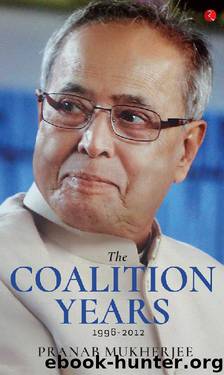THE COALITION YEARS by Mukherjee & Pranab

Author:Mukherjee & Pranab [Mukherjee & Pranab]
Language: eng
Format: epub
Tags: Mobilism
Publisher: Rupa Publications
Published: 2017-10-13T00:00:00+00:00
JOINT UPA–LEFT COMMITTEE
Nevertheless, due to the concerns raised by the Left parties, the government, on 30 August 2007, announced that a mechanism would be established to evaluate their objections. Thus, a Joint UPA–Left committee was constituted. The Congress was represented by P. Chidambaram, Kapil Sibal, Salman Khurshid and Veerappa Moily. From the Left, A.B. Bardhan and Sudhakar Reddy represented the CPI, Prakash Karat and Sitaram Yechury brought forth the views of the CPM, while Debabrata Biswas and Chandrachoodan and Abani Roy were members of the group from the Forward Bloc and Revolutionary Socialist Party (RSP), respectively. I was made the convener of this group.
It was decided that the committee’s findings would be taken into account before the operationalization of the civil nuclear cooperation.
The complete absence of a convergence of interests between the two sides meant that tempers ran high in every meeting of the committee. These meetings, conducted at my residence, were followed by a joint press briefing by Sitaram and myself. Prakash Karat was absolutely clear that the Left would not support any agreement with the US. In my assessment, Karat also believed that Sonia Gandhi would call off the deal owing to the stiff opposition from the Left. But I was determined to pursue it, despite this resistance, with a view to bolster our country’s ever-increasing energy requirements.
The committee met nine times between September 2007 and June 2008. The Left parties submitted six notes and rejoinders on the issues examined by the committee. The UPA, in response, submitted five notes, including one response to two rejoinders sent by the Left parties on the same day.
In our response to the Left parties we mentioned:
‘Hyde Act does not apply to India. India’s commitment will arise from the 123 bilateral cooperation agreement which once approved by the US Congress will become law. The 123 agreement as the prevailing law will then delineate the specific rights and the responsibility of the US and India that govern and control the agreement’s implementation.’123
The Agreement is not circumscribed by the various US laws and stands on its own since customary international law (Articles 26 and 27 of the Vienna Convention on the Law of Treaties, 1969) would ensure that the Hyde Act does not apply to India or override the agreement. Besides, the US Constitution provided for the treaties made under the authority of the US Government to be the supreme law of the land.
Download
This site does not store any files on its server. We only index and link to content provided by other sites. Please contact the content providers to delete copyright contents if any and email us, we'll remove relevant links or contents immediately.
| Military | Political |
| Presidents & Heads of State | Religious |
| Rich & Famous | Royalty |
| Social Activists |
Waking Up in Heaven: A True Story of Brokenness, Heaven, and Life Again by McVea Crystal & Tresniowski Alex(37678)
Empire of the Sikhs by Patwant Singh(22983)
We're Going to Need More Wine by Gabrielle Union(18975)
Hans Sturm: A Soldier's Odyssey on the Eastern Front by Gordon Williamson(18491)
Leonardo da Vinci by Walter Isaacson(13190)
The Radium Girls by Kate Moore(11935)
Tools of Titans by Timothy Ferriss(8230)
Educated by Tara Westover(7948)
How to Be a Bawse: A Guide to Conquering Life by Lilly Singh(7397)
Permanent Record by Edward Snowden(5751)
The Last Black Unicorn by Tiffany Haddish(5563)
The Rise and Fall of Senator Joe McCarthy by James Cross Giblin(5234)
Promise Me, Dad by Joe Biden(5090)
The Wind in My Hair by Masih Alinejad(5036)
A Higher Loyalty: Truth, Lies, and Leadership by James Comey(4852)
The Crown by Robert Lacey(4732)
The Iron Duke by The Iron Duke(4295)
Joan of Arc by Mary Gordon(4024)
Stalin by Stephen Kotkin(3885)
